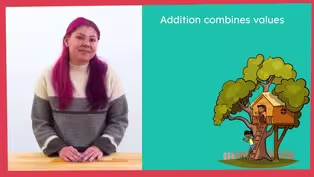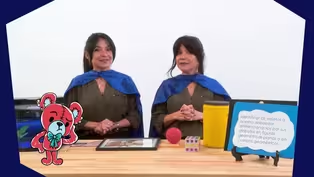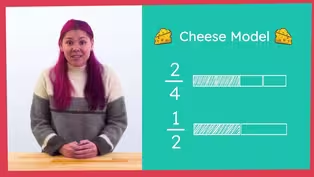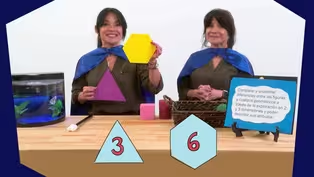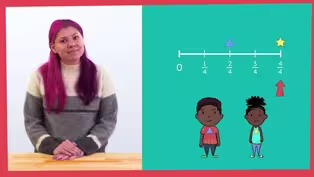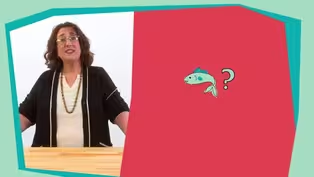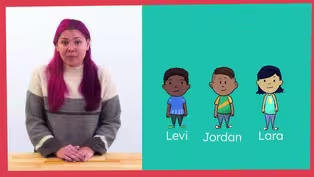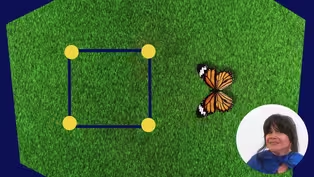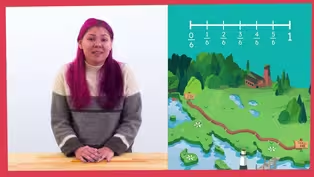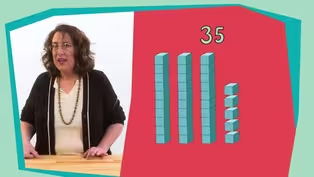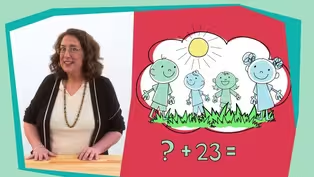
Episode 17 | Math Lessons
3/29/2021 | 28m 46sVideo has Closed Captions
Math lessons for early learners, led by NC teachers.
The first lesson (aimed at PreK-K learners) helps early learners represent a number of objects with written numerals. The second lesson (aimed at 1st-2nd graders) helps students use mental math to solve equations. Classroom Connection is your At-Home Learning companion where children love to learn. All lessons are led by NC educators.
Problems playing video? | Closed Captioning Feedback
Problems playing video? | Closed Captioning Feedback
At-Home Learning Presents: Classroom Connection is a local public television program presented by PBS NC

Episode 17 | Math Lessons
3/29/2021 | 28m 46sVideo has Closed Captions
The first lesson (aimed at PreK-K learners) helps early learners represent a number of objects with written numerals. The second lesson (aimed at 1st-2nd graders) helps students use mental math to solve equations. Classroom Connection is your At-Home Learning companion where children love to learn. All lessons are led by NC educators.
Problems playing video? | Closed Captioning Feedback
How to Watch At-Home Learning Presents: Classroom Connection
At-Home Learning Presents: Classroom Connection is available to stream on pbs.org and the free PBS App, available on iPhone, Apple TV, Android TV, Android smartphones, Amazon Fire TV, Amazon Fire Tablet, Roku, Samsung Smart TV, and Vizio.
Providing Support for PBS.org
Learn Moreabout PBS online sponsorshipMore from This Collection
Math lessons for early learners, led by NC teachers.
Video has Closed Captions
Math lessons for early learners, led by NC teachers. (28m 46s)
Video has Closed Captions
Math lessons for early learners, led by NC teachers. (28m 46s)
Video has Closed Captions
Math lessons for early learners, led by NC teachers. (28m 46s)
Video has Closed Captions
Math lessons for early learners, led by NC teachers. (28m 46s)
Video has Closed Captions
Math lessons for early learners, led by NC teachers. (28m 46s)
Video has Closed Captions
Math lessons for early learners, led by NC teachers. (28m 46s)
Video has Closed Captions
Math lessons for early learners, led by NC teachers. (28m 46s)
Video has Closed Captions
Math lessons for early learners, led by NC teachers. (28m 46s)
Video has Closed Captions
Math lessons for early learners, led by NC teachers. (28m 45s)
Video has Closed Captions
Math lessons for early learners, led by NC teachers. (28m 46s)
Video has Closed Captions
Math lessons for early learners, led by NC teachers. (28m 45s)
Video has Closed Captions
Math lessons for early learners, led by NC teachers. (28m 46s)
Providing Support for PBS.org
Learn Moreabout PBS online sponsorship[cheerful upbeat music] ♪ - Hi, super learners, and welcome to my classroom.
I'm your host, Mr. R, and I am so excited to hang with you today.
We're gonna have a really fun time together, and we're gonna learn at the same time.
You ready?
- Hello, super learners.
I am Ms. M. I'm so glad that you are here today.
Are you ready for another math adventure?
Well, let's get started with a song.
♪ Hello, super learners, how are you ♪ ♪ Hello, super learners, how are you ♪ ♪ I'm so glad you're here today ♪ ♪ And I hope you feel the same ♪ ♪ Hello, super learners, how are you ♪ I feel wonderful today, super learners, and I really hope you do, too.
Well, now it's time for our math power warmups.
Counting up to 20.
[air whooshes] Are you ready?
Here we go.
♪ One, two, three, four, five, six, seven ♪ ♪ eight, nine, 10 ♪ ♪ 11, 12 ♪ ♪ 13, 14, 15 ♪ ♪ 16, 17, 18 ♪ ♪ 19, 20 ♪ ♪ That was fun ♪ Let's count to 20 again.
Are you ready to snap count up to 20 with me?
Let's go.
One [snaps], two [snaps], three [snapping], four [snaps], five [snaps], six [snapping], seven [snaps], eight [snaps], nine [snapping], 10 [snaps].
Let's keep going.
11 [snaps], 12 [snaps], 13 [snapping], 14 [snaps], 15 [snaps], 16 [snapping], 17 [snaps], 18 [snaps], 19 [snapping], 20 [snaps], yes.
Super learners are the best.
I'm getting warmed up.
Are you?
Well, one more time counting to 20, but this time let's do it in Spanish.
[speaking in Spanish] You did it!
Now it's time to review our colors.
Let's say them in English and Spanish.
[speaks in Spanish] Red.
[speaks in Spanish] Orange.
[speaks in Spanish] Yellow.
[speaks in Spanish] Green.
[speaks in Spanish] Blue.
[speaks in Spanish] Purple.
[speaks in Spanish] Brown.
[speaks in Spanish] Black.
[speaks in Spanish] White.
And [speaks in Spanish], gray.
Look for these colors in the world today.
And now for our last math power warmup: the shape game.
You will see a shape on the screen.
And then you say its name in English and/or Spanish.
[speaks in Spanish] Square.
[speaks in Spanish] Circle.
[speaks in Spanish] Triangle.
[speaks in Spanish] Rectangle.
[speaks in Spanish] Rhombus.
[speaks in Spanish] Trapezoid.
[speaks in Spanish] Hexagon.
[speaks in Spanish] Cube.
[speaks in Spanish] Cone.
[speaks in Spanish] Cylinder.
[speaks in Spanish] Sphere.
Math-tastic, super learners!
We have finished all of our math warmups.
So now it is time for... [hands slapping] ♪ Our math mission of the day ♪ [air whooshes] Come on, let's check with Sparkles the Fish to see what our math mission is today.
[cheerful ukulele music] Thank you, Sparkles.
Here it is.
"Dear super learners: Your mission today is to write the numerals zero through 20 and also read numbers in order."
Super learners, a numeral is a written number like this.
This is a numeral for the number two.
So today, we will write our numbers from zero to 20 and read the numbers in order.
Super learners, I know we can do this mission.
Capes on!
Math power up.
[air whooshes] Let's go.
[air whooshes] All right, super learners.
I'm going to write numbers in the air with my finger.
You can write the numbers on paper if you can, or you can write the numbers with your finger in the air like me.
Let's start with one.
Oh, wait.
That's right.
We should start with zero.
Zero means no objects.
Ready?
Math power up.
Zero goes around like this.
Write with me.
[gasps] Now one, a line from the top to the bottom.
Very good.
Continue to follow along on the screen.
[upbeat music] Two looks like this.
Curve around and a bottom line.
Three, around to the middle, around to the bottom.
Four, a long line down, short line, connecting line.
Five, straight line on top, short straight line, and a curve on the bottom.
Six, start here, go down, circle back into the middle.
Seven, straight line on top, diagonal line to the bottom.
Eight, top curve like an S, then connect back to the top.
Nine, go around and then straight line down.
Now, 10, a one and a zero.
11, two ones.
12, a one and a two.
Keep going.
13, a one and a three, write it!
14, a one and a four.
You can do it.
15, one and a five.
16, one and a six.
You're doing great.
17, one and a seven.
Keep it up, super learners.
18, a one and an eight.
19, a one and a nine.
Almost to the end!
And 20, a two and a zero.
Great job, super learners!
We wrote our numbers from zero to 20.
I know there's another part to this mission, but before we do the next part, it's time for our math movement break.
Let's jump in.
You will see a number on the screen.
That's the number of jumps you should do.
Ready to jump with me?
Here we go.
Six.
One, two, three, four, five, six.
Four.
One, two, three, four.
Two.
One, two.
Five.
One, two, three, four, five.
Seven.
One, two, three, four, five, six, seven.
Ten.
One, two, three, four, five, six, seven, eight, nine, ten.
That was some great jumping, super learners.
Now back to our mission.
[air whooshes] Look at this chart!
I know it is Sparkles-approved.
Each number is written over a group of objects it represents.
See?
Three has three dots under it.
And zero has no dots under it.
The number zero represents no objects.
Nice chart and very informative.
The next part of our mission says to read numbers in order.
We should read the numbers that are on the board.
I'll go grab my star wand to point to the numbers.
I'll be right back.
Hold on, super learners.
[mischievous jazz music] Oh, great.
I am so ready to point and read to all of our numbers.
Are you ready, super learners?
Let's... [electronic tone] Oh, no.
You've got to be kidding me.
What happened?
[bright guitar music] Some of our numbers are missing!
It must have been the Math Burglar.
Looks like we're going to have to fill in some numbers, super learners.
Let's read our numbers and fill in the missing ones as we go.
Ready?
Math power up.
Remember, super learners, that numbers go in order, Just like the chart we looked at.
Here we go.
Let me go into my math power pack and get my little marker, here we go.
All right.
Zero, one, two.
Hmm, there's the first missing number.
What goes here?
That's right, the number three.
We know how to do that.
Great, there!
Let's keep going.
Three, four, five, six.
Uh-oh.
Another missing number.
What goes here, super learners?
Yes, a seven!
Let's write it in.
All right, let's keep going.
Seven, eight, nine, 10, 11... Oh now, what number goes here, super learners?
12, yes!
A one and a two.
A one and a two.
Really good.
12, 13, 14.
Uh-oh.
What goes here?
Yes, 15.
A one and a five.
Very good.
Almost there.
15, 16, 17, 18, 19... Oh dear, this is the last missing number.
What is it?
Oh, I hear you!
Yes!
It's 20!
A two and a zero.
20.
19, 20.
We did it, super learners.
We read our numbers in order and filled in the missing numbers.
We also solved the Math Burglar's tricky puzzle.
[air whooshes] Hey.
We wrote our numbers zero to 20 and read our numbers zero to 20.
Let's check back with Sparkles the Fish.
[happy music] Mission complete!
Hooray!
Congratulations, super learners.
You used your math powers and completed the mission.
What is it time to do?
Let's review.
Today, we wrote our numbers using numerals.
Numbers are written in the order that we count them.
Each numeral represents a number of objects.
Zero represents zero objects.
Practice writing your numbers today, super learners.
You can share your math power by showing it to someone.
Thank you, super learners, for going on a math mission with me today.
Sparkle thanks you too.
Remember, you have the power to be super at math.
Bye!
Adios!
Math power out!
[upbeat music] - I hope you love numbers even more now after that awesome lesson.
Do you have a favorite number?
I like eight.
Why?
Because it's the Chinese number for good fortune.
Numbers can be beautiful, just like words.
- Hi, my name is Zach, and today I'm gonna teach you how to fold a balancing heart.
We're gonna start right side up.
and we are gonna valley fold in half.
[gentle guitar music] Now we're gonna unfold and fold these two flaps into the center.
Then we're gonna fold in half again on that valley fold.
And we are going to fold these two corners in, to taste, so if you wanna fold them in more like this, you can, you gonna fold them in less, you can, but I like it in those like a square right in the center.
Now crease those sharply and unfold.
Now unfold this flap like that.
Now this is a mountain fold so we're gonna reverse it and do a valley fold.
So just fold right there.
Now we are going to get this right here and along this triangle, we're going to valley fold every piece so just pinch between this pinch point and here.
And do the same here.
If you made sharp creases, it won't matter if you don't do it though, then the center should be a mountain fold.
So just mountain fold it like that.
And then you can re-close it, and that should kind of go down like that.
And then you've finished the balancing heart.
So then how you balance it, you put your finger in the back and you hold it like that.
- Wow, I hope you like that as much as I do.
What was your favorite part?
Well, let's not stop the party now 'cause I'm ready to learn some more.
[funky music] - Hi, friends.
My name is Dawn, [text popping] and I am very happy to be here with you today.
I brought my friend Splat with me too, and he's super excited to be here.
[robotic beeping] Today, we are going to do something fun called a number talk.
Number talks help us practice solving math problems in our head using any strategy we like.
Then, we explain how we solve the problem using our math words.
I'm going to show you an expression such as 2 + 2.
We're going to solve this using mental math or math in our head.
Then, you will have a chance to explain your answer to an adult or a stuffed animal [cat meows] or even Splat.
[robotic beeping] There are so many ways to solve math problems, and Splat and I want to help you use different strategies for solving.
[air whooshing] Addition.
We hear that word a lot, but do we think about what it really means?
Let's use a Frayer Model to think about it some more.
Let's take a piece of paper and fold it in half hamburger-style.
And then fold it in half again to make four equally sized rectangles.
Then, in the corner of our paper where all the sides are folded, we'll fold down a small triangle.
When you unfold your paper, the fold should look like this.
Does yours look like mine?
Okay, great!
We're going to write addition in the center diamond because this is the word we need to understand more about.
Then, in the upper left rectangle, we're going to define or write what addition means.
So let's write the word definition here.
Okay, great.
In the upper right rectangle, we're going to provide an example of addition.
So let's write example here.
Then, in the lower left rectangle, we'll provide a non-example or what addition is not.
So let's write non-example here.
And finally, in the lower right rectangle, we'll draw a picture to help us visualize what addition is.
So let's write picture here to remind us of what we're supposed to do.
Now we're going to define addition together.
So let's think, and then write the definition in our upper left rectangle.
So if Splat and I are outside in the North Carolina mountains picking apples, we would combine his basket of apples and my basket of apples into one big basket, and count to see how many we have in all.
This would be addition.
So addition is when we join groups of objects together.
Splat and I are gonna give you some time to write this definition in your Frayer Model.
[soft electronic music] As we learn more about addition in today's lesson, you will be able to add examples, non-examples, and draw a picture to show your growing understanding of addition.
[air whooshing] To help us organize our thinking, we'll use a chart like this.
We will add math problems to each box, and then we will show our thinking on how we solved these problems.
Before we get started, you might want to gather a few things.
You might want to get a stuffed animal or trusted adult to talk to so that you can explain your thinking.
You also might want to get some paper and pencil or a notebook to write down your learnings at the end of our time together.
This could be your math journal.
We'll wait while you go find your materials.
[air whooshing] [cheerful music] [air whooshing] Welcome back.
[cat meows] Splat and I hope you found everything you need for our math lesson.
Let's get started.
Here's our first expression: 5 + 5.
I want you to think in your head how you would solve this.
[gentle electronic music] Now, can you tell me the answer?
Did you say 10?
That's correct!
How did you know that was 10?
I bet you know your doubles, and so you knew that 5 + 5 = 10.
What a great job using your doubles to solve this problem.
Let's do another one.
Are you ready, Splat?
Our next expression is 5 + 6.
Will you think about what that answer is?
Tell an adult or stuffed animal what you think the answer is.
Okay, Splat, what do you think the answer is?
Whisper it to me.
[gasps] Oh, Splat whispered to me that the answer is 11.
Is that what you said?
You are correct.
Great thinking!
Now, can you tell me how you know the answer is 11?
Whisper it to me.
Oh, I heard someone say that they know 5 + 5 = 10 because they know their doubles.
Next, they know that 6 is one more than 5, so if 5 + 5 = 10, then 5 + 6 must be 11.
Wow!
That is a great way to use your doubles plus one to solve this expression.
Let's try another one.
Our next one is 6 + 6.
Will you think to yourself what the answer is?
Now, tell Splat what you think the answer is.
Did you say 12?
That's correct.
Will you tell Splat how you figured out the answer?
I heard some of you say that 5 + 6 = 11, so 6 + 6 = 12, because 6 is one more than 5, so the answer will be one more than 11, which is 12.
That is really great thinking about numbers.
But you know what?
I heard some of you say that you know that 5 + 5 = 10, and so 6 + 6 = 12 because 6 is one more than 5 and there are two sixes.
So the answer has to be two more than 10.
Whoa, that is some really hard thinking about doubles.
Here is our last expression.
Use what you know about doubles to help you solve this problem: 6 + 7.
Will you think for a minute in your head about how to solve this?
[gentle guitar music] Now, will you tell Splat what your answer is?
Did you tell Splat 13?
[robotic beeping] That's great!
And that's correct.
Great job figuring that out.
Will you tell Splat how you knew the answer was 13?
Splat heard someone say that they knew that 6 + 6 = 12 because you know your doubles.
And this problem was 6 + 7, and the 7 is one more than 6 so the answer has to be one more than 12, which is 13.
Splat told me that he knew the answer was 13 but he solved it a different way.
He knew his doubles and knows that 7 + 7 = 14.
He noticed that 6 was one less than 7.
So the answer must be 13.
He used his doubles minus one to solve the expression.
This is a great way to use what you know about doubles to figure out the answer.
[air whooshing] You worked really hard to solve expressions in your brain today using doubles and near doubles to help with mental math.
You also worked hard to explain your thinking so we could know how you solved the math problems.
Being able to explain your thinking is very important in math.
[robotic beeping] Splat and I would love to hear what you learned today in your own words.
I have these sentence starters and I'm hoping you can finish these sentences with me.
They say: "Today in math, I learned... And I can..." So I might say, "Today in math, I learned how to solve problems in my head.
I can use doubles or near doubles to help me find sums easier."
Now it's your turn.
Read this with me and finish it by telling an adult or a stuffed animal.
Today in math, I learned... [soft music] Oh great job.
Now let's read our next sentence and you finish it.
I can... You are doing a great job talking about your math learning.
Next, you could write on paper the sentences you just said out loud and start a math journal.
[cat meows] Splat and I also want to continue on our Frayer Model to show our learning about addition.
We want to add an example of what addition is to our paper.
You might say an example of addition is 5 + 5, since this would be an example of adding two groups of 5 together.
We'll give you time to add that to your paper.
For non-example or what addition is not, we could write 10 - 5 since this is subtraction and not addition.
Go ahead and add that now.
Next, Splat and I challenge you to add a picture that shows what addition is to your paper to help show your understanding of what we did today.
You can also add more examples and non-examples of addition.
Then you can share your learning with a trusted adult or stuffed animal.
Splat and I must go now.
We hope you are proud of your hard work solving math problems in your head using doubles and near doubles.
[air whooshes] - I am Vivienne.
I'm eight years old, and this joke will be knock, knock.
- [Woman] Who's there?
[snare drum rattling] - Interrupting cow.
- Interrupting cow- - Moo!
- That was awesome!
My good people, we learned a lot and I'm sure that your brain is getting bigger and stronger every day.
Learning is so important.
Without it, you could never get better at things like running, reading, making up stories.
Without learning, we'd be the same person every day and we'd never grow up.
[cheerful upbeat music] ♪


- Home and How To

Hit the road in a classic car for a tour through Great Britain with two antiques experts.












Support for PBS provided by:
At-Home Learning Presents: Classroom Connection is a local public television program presented by PBS NC
